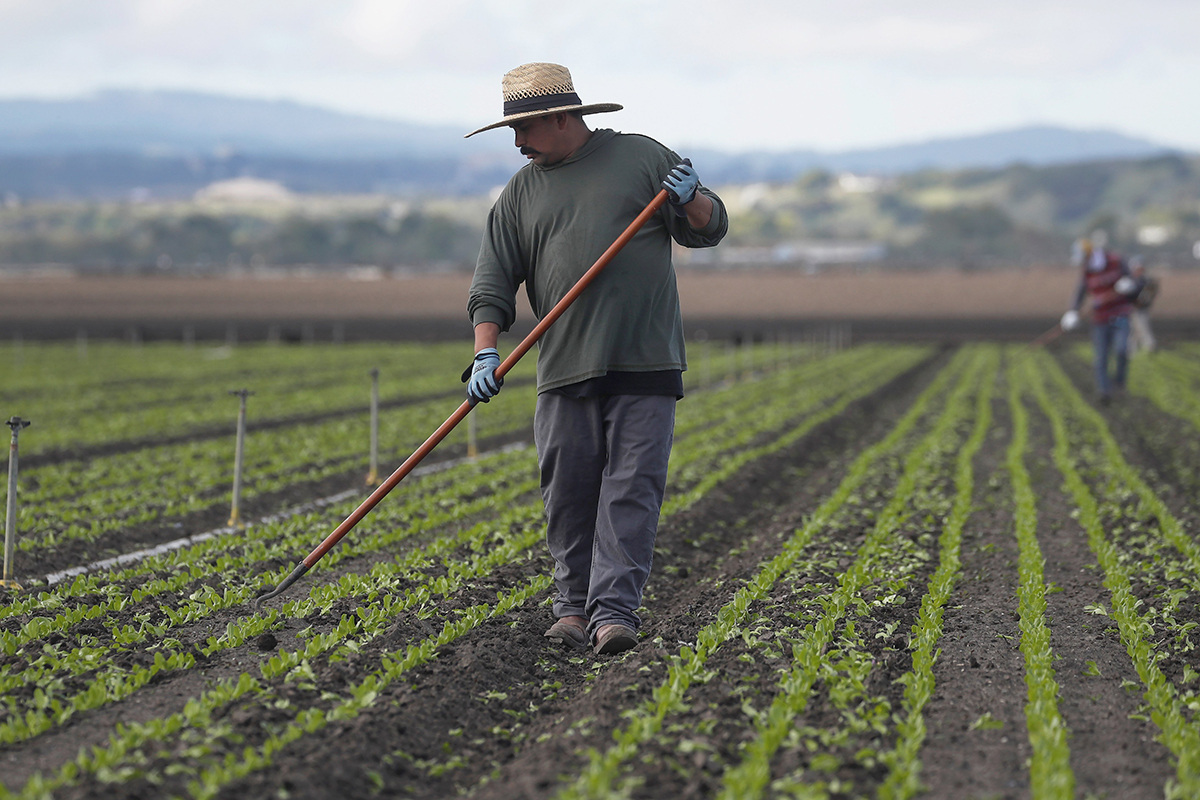(OSV News) — “If you want to remember me, organize,” said César Chávez, the legendary Mexican-American labor leader who for decades championed U.S. agricultural workers in a nonviolent struggle to improve their working and living conditions.
An estimated 2.9 million seasonal, migrant, and resident laborers annually stream to dusty fields across the country to pick America’s produce. At the height of its influence, their union — United Farm Workers — had 60,000 members. It was a force to be reckoned — or bargained — with.
But UFW’s membership has since dwindled to roughly 7,000-8,000 members. Several labor, legislative, and ministry leaders told OSV News that unionized agricultural labor faces enormous hostility and stiff resistance from corporations when it comes to advancing the rights and dignity of workers who secure fresh food for American tables.
“California in 1975 became the first state in the country to give farmworkers unionization rights. Today, we’ve got that up to two states — California and New York State have some version of farmworker unionization rights,” Antonio De Loera-Brust, director of communications for the UFW, told OSV News. “So that leaves 48 states where that’s not true, to this day. That’s a pretty stunning statistic.”
Walking with Farmworkers
Jesuit Father Tom Florek, executive director of the Catholic Migrant Farmworker Network, also witnesses the insecurity of farmworkers’ lives.
“Oftentimes, the reality between what they’re promised and what is produced in terms of the working relationship changes,” Father Florek told OSV News. “If you get workers who might say something — ‘Well, this wasn’t the agreement’ — they’re risking not returning next year. They could be blacklisted. If you’re a single person raising a voice, there’s no power there. They’re not going to get very far.”
An H-2A Temporary Agricultural Workers’ visa offers only some protection; recruiters may nonetheless charge unauthorized fees for transportation and housing, Father Florek said.
Given no shortage of injustices, CMFN is developing Sembrador — “sower of the seed” in Spanish — a network of parish communities to assist farmworkers. CMFN is also linked with both government and non-government agencies to protect the rights of workers.
Simple companionship, however, remains important.
“If you say, ‘I’m Father Tom; I’m here visiting. Tell me how can the Catholic Church serve you?’ Without hesitation — without hesitation — they’ll say, ‘Give us a blessing,'” he said.
Father Florek admits this may sound weak.
“It’s not. What they’re looking for is accompaniment. And next to mother is mother church,” he said. “And what sustains people is a sense that God is with them.”
While the National Agricultural Law Center reports 14 states guarantee some form of collective bargaining, these agreements vary widely in terms of scope, definitions, right to strike, and other important protections considered essential by the UFW. “The only two states where there’s a legal process for getting the employer to negotiate a contract is California and New York,” De Loera-Brust noted.
As of Jan. 1, California enacted a new law (AB 2183) that made several significant changes to the 1975 California Agricultural Labor Relations Act, creating new methods for a union to be certified as the exclusive collective bargaining representative of farmworkers protected by the ALRA.
“Up until recently, the (union) elections had to happen on employer property. And that just made it impossible for workers to vote in secret,” explained De Loera-Brust. “It meant that workers were subjected to threats, to intimidation; some folks were deported; people were fired simply for being involved with the union.”
Threats of being fired represent a “significant financial risk for people who are barely making ends meet as it is,” De Loera-Brust added.
When the National Labor Relations Act of 1935 passed, it federally guaranteed collective bargaining power to all American workers — except those in the agriculture and domestic work industries. The issue was left to each state. As legal scholars have noted, this exclusion wasn’t coincidental. The vast majority of workers in these jobs were and are people of color, a segment some lawmakers in 1935 didn’t wish to enfranchise.
The UFW’s current national expansion strategy relies upon legislation and organizing. But even with some recent legislative progress, “it’s still going to be a really hard industry to organize in,” De Loera-Brust observed. “A workforce that’s scared of getting deported is not going to be a workforce that’s super easy to unionize.”
An estimated 50% of farmworkers are unauthorized immigrants.
Immigration reform poses a continuing challenge, although De Loera-Brust emphasizes it shouldn’t. “Our argument for immigration reform is simple: If you feed America, you deserve the right to stay in America … Agriculture would not function without immigrant labor — and the first people to tell you that would be many of our historical opponents among the employers.”
As AB 2183 advanced in the California legislature after a previous failure, the UFW found an ally in the California Catholic Conference.
“The church has a long stance on the right of all workers to form unions,” said Linda Wanner, the conference’s Associate Director for Governmental Relations. “So under Catholic social teaching, we jumped on board with that bill.”
A 2022 letter of support sent to California Gov. Gavin Newsom declared, “as the official public policy voice for the Catholic Church of California, we request that you sign AB 2183 into law.”
Gov. Newsom, however, was seemingly unconvinced; he continued to voice resistance to AB 2183. And so began a 24-day march from Delano, California — site of a five-year grape workers’ strike from 1965-1970 — to the state capitol in Sacramento.
Assisted by the UFW, the “peregrinación” (“pilgrimage”) lasted from Aug. 3 – 26, 2022, and mirrored the grape strike route organized in 1966 by César Chávez.
The arrival of the marchers was marked with a Mass, celebrated by Bishop Jaime Soto of Sacramento.
“I knew that for many of the marchers that was important for them,” Bishop Soto told OSV News. “It’s an important event for them to be able to gather at the Lord’s table — both from a physical as well as a spiritual dimension. They needed to be nourished.”
The welcome of the church, Bishop Soto said, transcended the uncertain political environment. It was a visible sign that “whatever political success or failure they would have in the cause, they know they’re on the right side, and God is walking with them … they’re not just laborers; they’re not just economic actors — they are sons and daughters of God.”
Bishop Soto added, “They didn’t need the governor’s approval to know that what they were doing was right.”
He emphasized “the right of workers to organize — that’s a fundamental Catholic social and moral principle.”
The peaceful, non-violent witness of the marchers also impressed Bishop Soto, who found it “remarkably unique in the political climate that we’re dealing with now.” He explained that “it was important for me — and for the church — to affirm their human dignity and the human responsibility to participate in the political process, and bring their voice into that process.”
Bishop Soto said, “The farmworker cause came out of a whole reality that most Californians are unaware of.”
That reality is a harsh one, according to Appaswamy “Vino” Pajanor, chief executive officer of Catholic Charities of the Diocese of San Diego. Pajanor wanted to experience a typical farmworker’s day, so into the fields he went.
“Just that one-day experience, I was shaking my head,” Pajanor told OSV News. “How are we not seeing this? How are we not realizing the sweat and blood — I’m talking about real blood — that they really give up in the fields, just to produce our fresh fruits and fresh vegetables that we eat?”
Workers rise at 2:00 a.m., eat a small breakfast, and hope they will be chosen by recruiters for the day. If they are picked, wages are low, breaks are infrequent, work can be dangerous, and there’s chemical exposure.
“That’s not what I see in the supermarket. That’s not what I see at Costco or Walmart when I buy the food,” said Pajanor. “I do not know who bled that day, that minute, to harvest that crop.”
“There was somebody behind that who made this happen,” he said, reflecting on that experience. “It’s a different understanding of how the food came from that field to that table.”
Kimberley Heatherington writes for OSV News from Virginia.












































